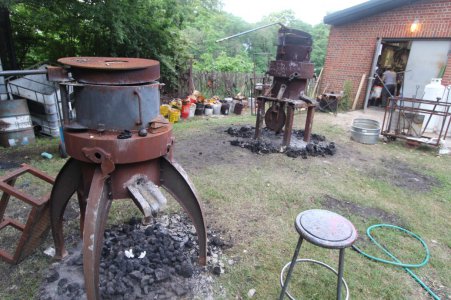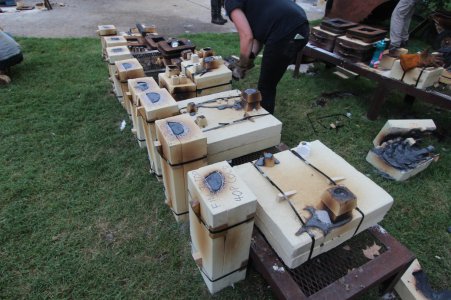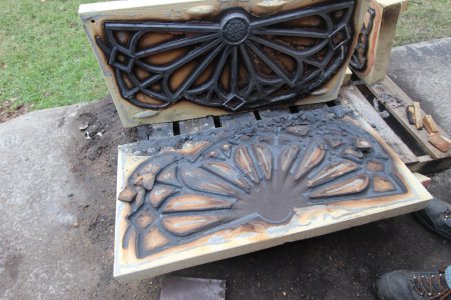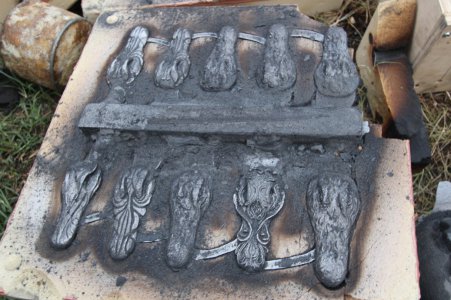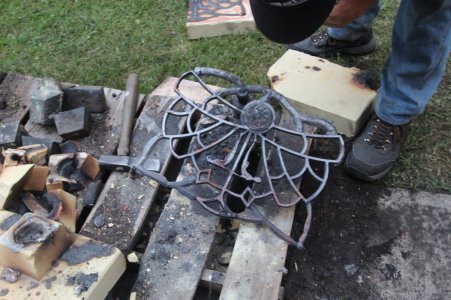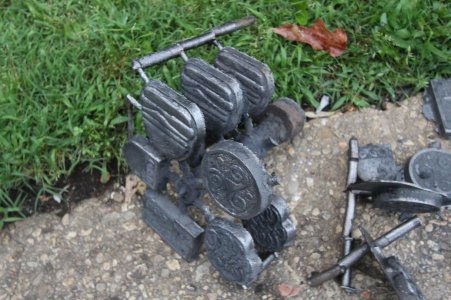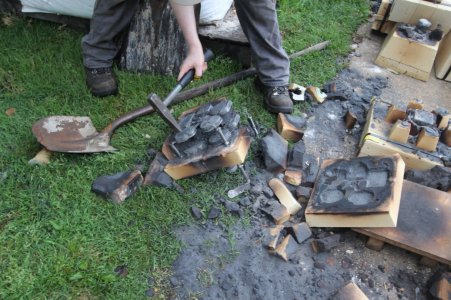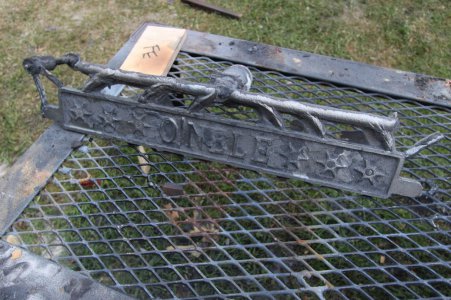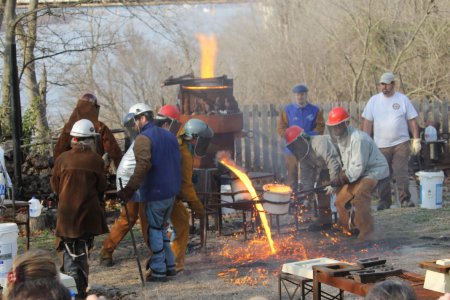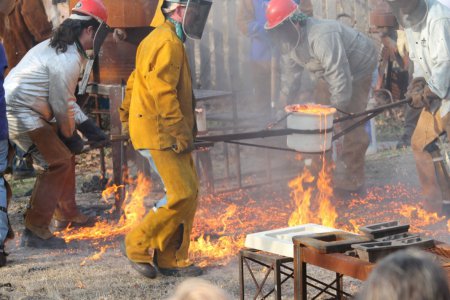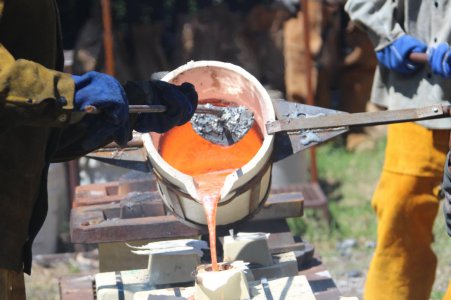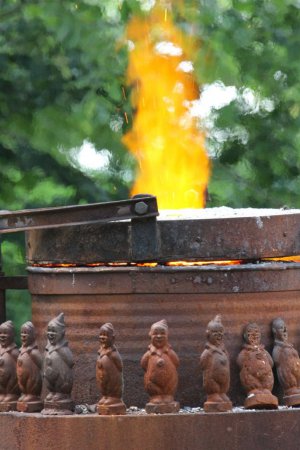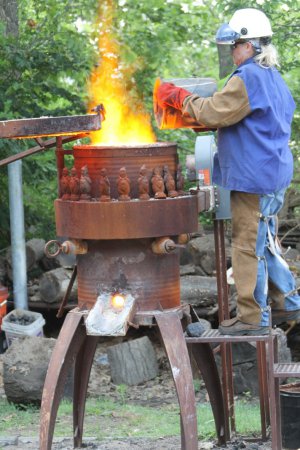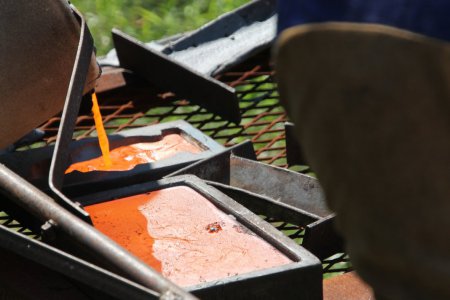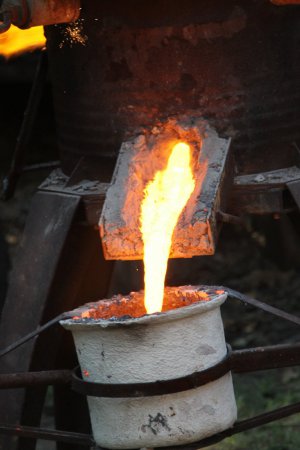-
Welcome back Guest! Did you know you can mentor other members here at H-M? If not, please check out our Relaunch of Hobby Machinist Mentoring Program!
You are using an out of date browser. It may not display this or other websites correctly.
You should upgrade or use an alternative browser.
You should upgrade or use an alternative browser.
My Iron-Melting Furnace
- Thread starter greentwin
- Start date
- Joined
- Mar 21, 2018
- Messages
- 1,716
Great write-up. About the art show, I was appalled by the pouring/spilling of molten iron onto the ground. A little water in the soil underneath and the art show becomes a fireworks show. As for your pour, you should always pour over a sand bed. That way, when your crucible fails one day with a full charge, it won't become much of an issue with molten metal on the ground
- Joined
- Jun 21, 2022
- Messages
- 84
Thanks,Amazed at the amount of work required to make a furnace…
Thank you for sharing the process with us!!
Very, very cool!! I mean hot, but cool
You can make a furnace using ceramic blanket, but they do not last as long as a furnace with a cast refractory hot face.
The ceramic blanket needs to be coated with material that will prevent the fibers from becoming airborn and inhaled.
I went with the long lasting approach, which is more build time on the front end, but almost no maintenance after that.
In spite of the cracking that occurred in my hot face, it was easily repaired, and continues to work like a champ.
All hot faces crack. As long as they don't crumble then cracks are patched easily enough.
.
Last edited:
- Joined
- Jun 21, 2022
- Messages
- 84
Thanks, I am glad folks are enjoying the photos. I love attending these art-iron shows, although most have shut down for the last 3 years or so.Great write-up. About the art show, I was appalled by the pouring/spilling of molten iron onto the ground. A little water in the soil underneath and the art show becomes a fireworks show. As for your pour, you should always pour over a sand bed. That way, when your crucible fails one day with a full charge, it won't become much of an issue with molten metal on the ground
I can't wait to see them start back up again.
They water the grass in the weeks before the show, and then water it again after the show, and it grows back quickly.
Grass is a renewable resource, so not a problem.
It was really dry that day, and so there was more grass burn than you would normally see at an iron pour.
They actually have art-iron shows where the sling buckets up moten iron up into the air into the most fantastic display.
Iron is not really as dangerous as some would make it, but I do have some hand burn photos I will post, and one does have to be very cautious when handling molten iron.
I have heard a number of folks mention the sand bed, but I have never used one, and have spilled both molten iron and molten aluminum onto concrete, with no effect at all. My concrete is a bit old. For new concrete that has high strength, I have seen a spill spald out a spot. I would not pour over new concrete, but my driveway needs replacing anyway.
There is danger of moisture being in sand on the ground and causing an explosion during a spill, so sand is not really as safe as you may think.
I use high quality crucibles, and they are not known for failure, but one never knows.
I did have a crucible fall out of my early pouring shank (poor design), and it dumped a #10 full of molten iron on the concrete, but no problem, and no damage even to my driveway, but again, my driveway concrete is pretty weak stuff.
Everybody has to come up with the methods and materials they feel safe and comfortable with.
Many backyard casters do use a sand bed. I don't, and I know another guy in Australia who does a lot of iron, and he pours exclusively over concrete, and has done so for 20 (+) years without problems, even with spills.
Edit:
I showed my iron pour videos to one fellow, and he noted "There is not a single fire extinguisher in sight".
LOL, it did not even occur to me that I needed a fire extinguisher, and I generally don't set one out, but having an extinguisher on hand is not a bad idea.
I generally don't put anything flamable or anything with moisture within about 20 feet of the furnace.
My main concern is preventing molten iron from contacting my skin. That is pretty much all I worry about.
The worst furnace fire I have seen is when someone melted the fuel line going to the furnace, and started a large puddle fire.
I don't operate my furnace near the house, just for this reason. And in the future, I am going to cover my fuel line, probably with flexible metal conduit sheathing, so a spill does not open up the fuel line.
Diesel is very reluctant to burn unless it is vaporized, and even then it is very tame (I will post a video).
Kerosene is much more volatile, and I don't use kerosene, mainly because it is very expensive in this area, but also for safety reasons.
You can drop lit matches into a container full of room-temperature diesel, and you cannot light it. Basically there are no vapors to light with diesel.
.
Last edited:
- Joined
- Jun 21, 2022
- Messages
- 84
My first pouring shank design was not a good one.
The retainer did not work well due to variations in the exact size of crucibles, and so just as I began pouring a full #10 of iron, the crucible slipped out of the pouring shank.
This is the reason you wear leather boots when you pour, and a leather jacket, leather chaps, etc.
And your pants legs go over the top of the boots (nothing worse than molten iron running into your boot).
There was a big splash of iron everywhere, and most of it ran harmlessly off of my leather, but a few tiny droplets ran down inside my gloves.
By the time I got my gloves off, the damage was done.
Luckily molten iron vaporizes nerve endings, and so there was no pain.
It took a while for the scar tissue to fill in the spots.
I generally wear a full face shield and safety glasses, to give two layers of protection.
And I redesigned my pouring shank, so that the crucible is retained regardless of what height it has, or how it sits in the shank supports.
There is no sign of these burns on my hands now, but definitely a lesson learned.
Use very good equipment, and high quality crucibles.
Don't use thin or worn out crucibles.
Keep your poor area as clean and uncluttered as possible.
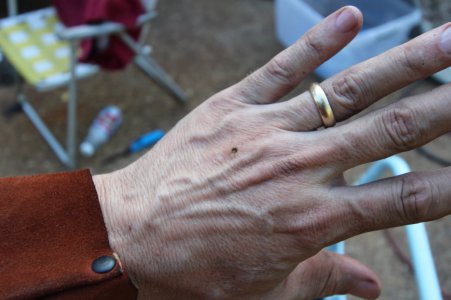
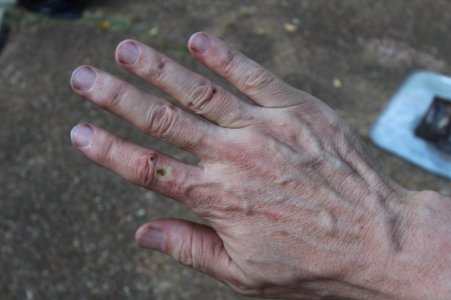
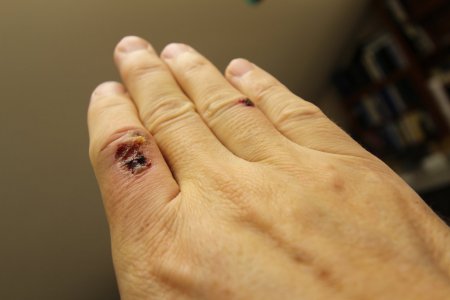
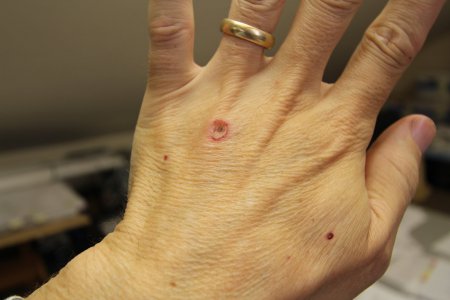
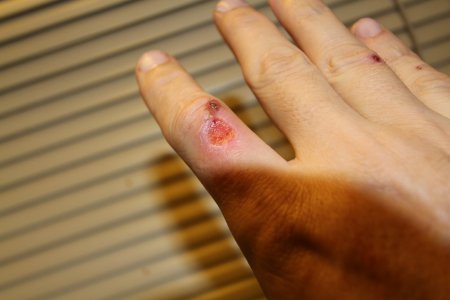
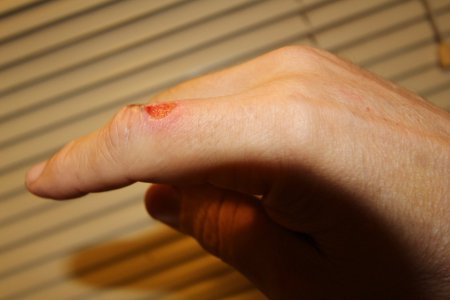
The retainer did not work well due to variations in the exact size of crucibles, and so just as I began pouring a full #10 of iron, the crucible slipped out of the pouring shank.
This is the reason you wear leather boots when you pour, and a leather jacket, leather chaps, etc.
And your pants legs go over the top of the boots (nothing worse than molten iron running into your boot).
There was a big splash of iron everywhere, and most of it ran harmlessly off of my leather, but a few tiny droplets ran down inside my gloves.
By the time I got my gloves off, the damage was done.
Luckily molten iron vaporizes nerve endings, and so there was no pain.
It took a while for the scar tissue to fill in the spots.
I generally wear a full face shield and safety glasses, to give two layers of protection.
And I redesigned my pouring shank, so that the crucible is retained regardless of what height it has, or how it sits in the shank supports.
There is no sign of these burns on my hands now, but definitely a lesson learned.
Use very good equipment, and high quality crucibles.
Don't use thin or worn out crucibles.
Keep your poor area as clean and uncluttered as possible.






- Joined
- Jun 21, 2022
- Messages
- 84
I have a variety of crucibles.
My favorite, and the only type I use these days for iron is the "Morgan Salamander Super".
The Salamander Super can be used for any metal (not for melting steel though), but it is "ferrous-metal-rated", and also rated for iron temperatures at 2,900 F.
Many crucibles are not "ferrous-metal-rated", and not rated for iron temperatures, and so I have seen crucibles fold up like wet cardboard when people try to use them to melt iron.
And you have to place two layers of cardboard under the crucible, on top of the plinth, otherwise the crucible will adhere to the plinth.
The red crucible is a great crucible for for aluminum, but not rated for ferrous metals or iron temperatures.
And the "Salamander" name is unfortunately used on several crucible types.
A "Salamander Hi-Melt" is not ferrous-metal rated, and not rated for iron temperatures.
For iron, it has to be the "Slamander-Super", so be aware.
It should be noted that a rough approximation of the capacity of an A-shaped crucible is that a #10 will hold 30 lbs of gray iron.
The charts typically list the "brim-full" capacity of the crucible, and brim-full is too full to be poured without spilling.
A realistic capacity for an A10 crucible is between 20-25 lbs of iron.
Using the same A10 for aluminum, your volume of melted metal will be the same, but the total melt metal weight will be about 1/3 that of iron.
And it is not a good idea to use once crucible for multiple metal types, ie: don't use a crucible to melt aluminum, and then use that same crucible to melt iron.
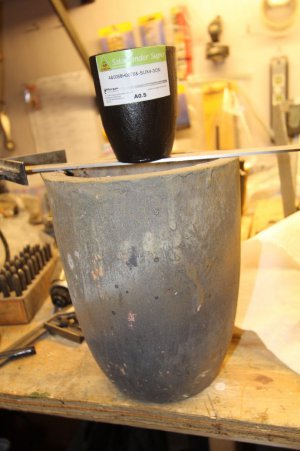
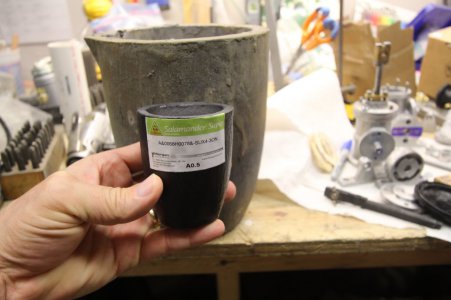
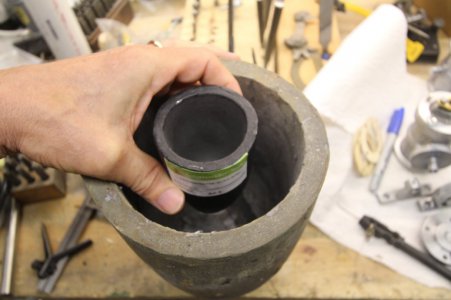
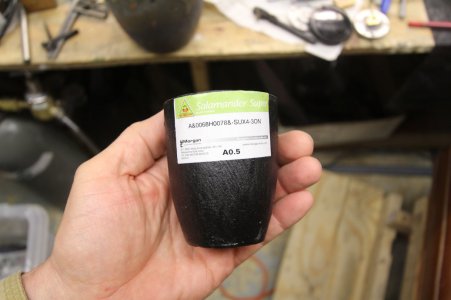
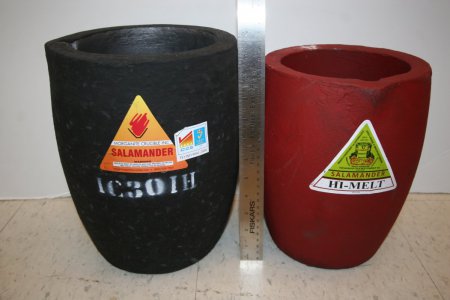
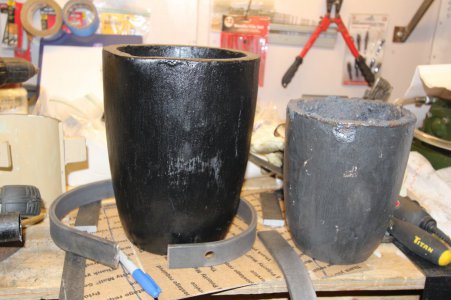
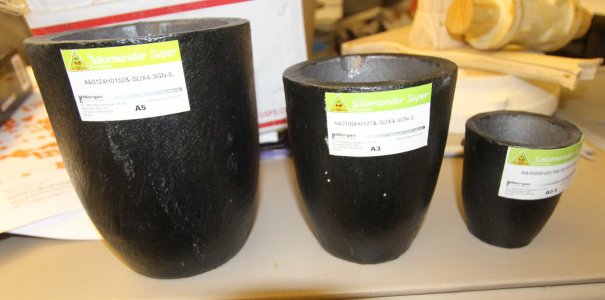
My favorite, and the only type I use these days for iron is the "Morgan Salamander Super".
The Salamander Super can be used for any metal (not for melting steel though), but it is "ferrous-metal-rated", and also rated for iron temperatures at 2,900 F.
Many crucibles are not "ferrous-metal-rated", and not rated for iron temperatures, and so I have seen crucibles fold up like wet cardboard when people try to use them to melt iron.
And you have to place two layers of cardboard under the crucible, on top of the plinth, otherwise the crucible will adhere to the plinth.
The red crucible is a great crucible for for aluminum, but not rated for ferrous metals or iron temperatures.
And the "Salamander" name is unfortunately used on several crucible types.
A "Salamander Hi-Melt" is not ferrous-metal rated, and not rated for iron temperatures.
For iron, it has to be the "Slamander-Super", so be aware.
It should be noted that a rough approximation of the capacity of an A-shaped crucible is that a #10 will hold 30 lbs of gray iron.
The charts typically list the "brim-full" capacity of the crucible, and brim-full is too full to be poured without spilling.
A realistic capacity for an A10 crucible is between 20-25 lbs of iron.
Using the same A10 for aluminum, your volume of melted metal will be the same, but the total melt metal weight will be about 1/3 that of iron.
And it is not a good idea to use once crucible for multiple metal types, ie: don't use a crucible to melt aluminum, and then use that same crucible to melt iron.







Last edited:
- Joined
- Jun 21, 2022
- Messages
- 84
You are welcome.Thanks for taking time to post so much detail. This is super interesting!
I would like to see more folks get into iron casting.
Perhaps even start an iron casting club, with regional iron-casting festivals/events and such.
The art-iron festivals that I have attended have been instrumental in teaching me how to consistently and successfully cast gray iron, and I am very grateful to those folks for showing me how to do it correctly.
.
- Joined
- Jun 21, 2022
- Messages
- 84
Here are the lifting tongs that I fabricated.
Some folks use combination lift and pour tongs, but since iron is so heavy, I have never found lift-and-pour tongs to be functional.
I use a mechanical stop on my tongs so at to not apply excessive force to the somewhat fragile clay-graphite crucible.
The crucible is suppose to be lifted by the lower part, and never by the upper part or upper lip.
These tongs work well. They could have been made not quite as wide (if I were only using a #10 crucible), but I think I can use them for the next larger size crucible.
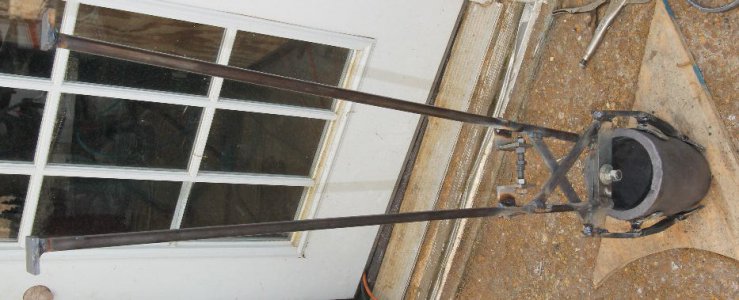
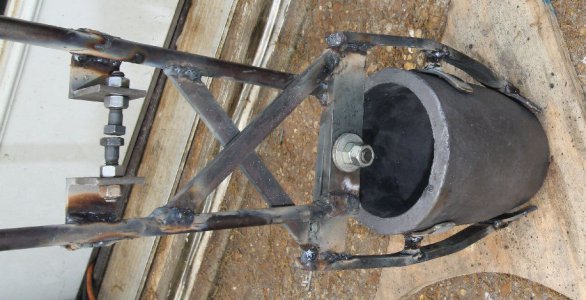
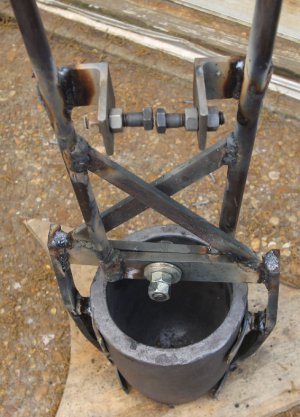

Some folks use combination lift and pour tongs, but since iron is so heavy, I have never found lift-and-pour tongs to be functional.
I use a mechanical stop on my tongs so at to not apply excessive force to the somewhat fragile clay-graphite crucible.
The crucible is suppose to be lifted by the lower part, and never by the upper part or upper lip.
These tongs work well. They could have been made not quite as wide (if I were only using a #10 crucible), but I think I can use them for the next larger size crucible.





